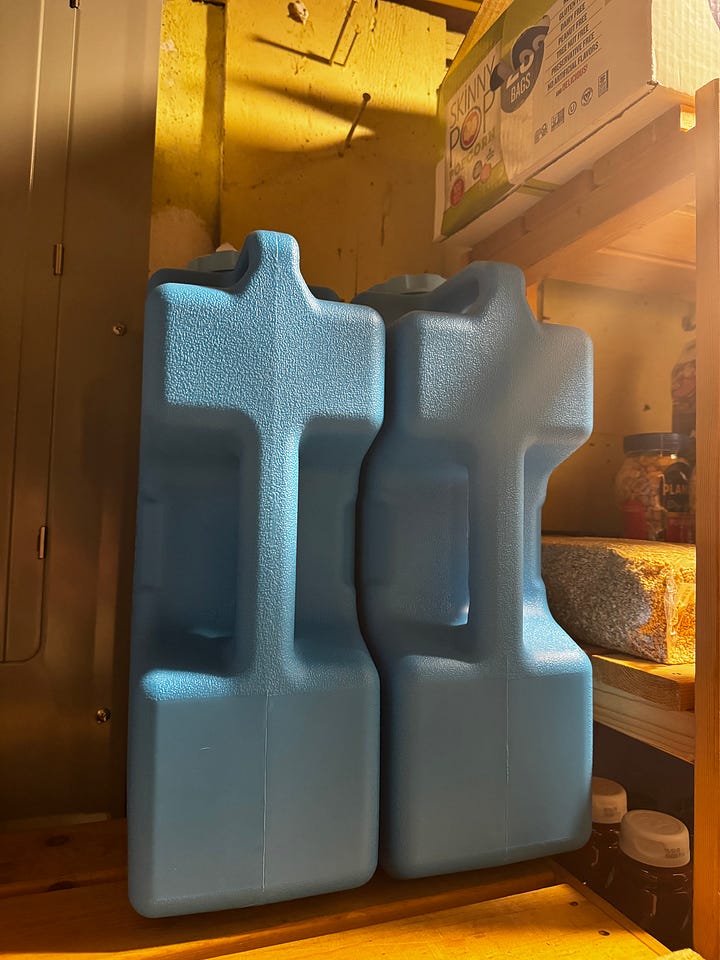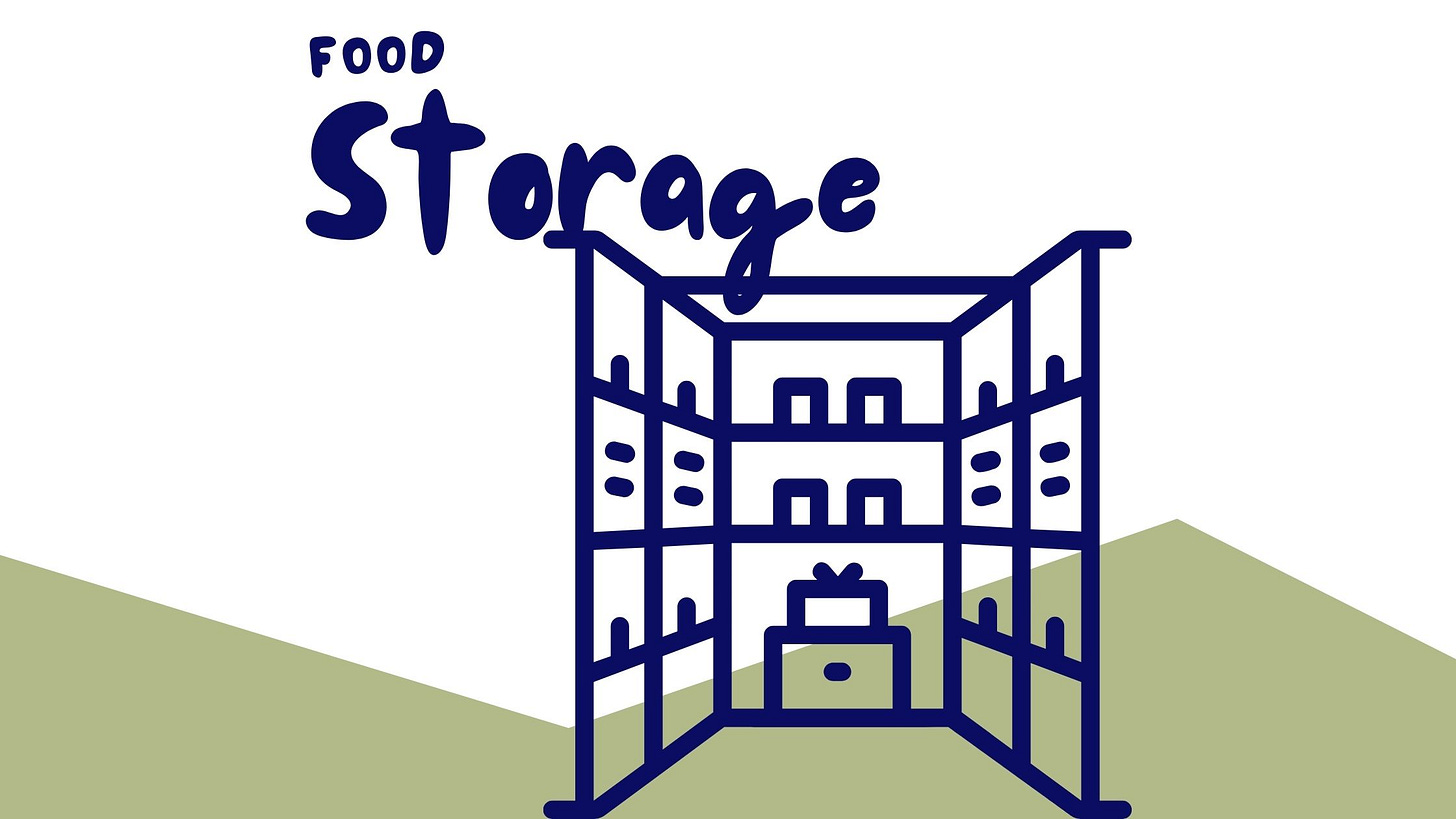Prep Series Week 3: Food Storage
This is part four of our ten-part toolkit series providing a step-by-step guide about how to prepare for disaster. You can read Parts 1-3 in the Resources & Toolkits page of Cramming for the Apocalypse.
Whole books (and courses!) have been made about building up your preparedness food storage. If you want to build your dedicated food storage (which is a separate kit from your everyday pantry), the best way is to think in terms of meals. Plan 3 full meals, plus snacks (and maybe dessert!) for every person in your household. Note all dietary restrictions and preferences. A disaster is not the time to force your stressed out five-year-old to like black beans. So think about what you and your family like to eat on a regular basis and stock up accordingly. There’s a lot you can do with canned foods!
But first, for this week’s workbook:
Meal Planning
Let’s start with meal planning. Instead of stocking up on a bunch of random canned goods on your next trip to Costco, you’ll want to think strategically about this by planning out your meals for at least 7-10 days.
Therefore, start by planning a 7-day menu: 7 breakfasts, 7 lunches, 7 dinners, 7 days worth of snacks and at least 3 desserts (if not 7, because why not?). Now, reverse engineer how you can make them shelf stable–meaning, they don’t need refrigeration.
First, think about which meals would be easier to “automate.” By automate, I mean that you can plan for the same thing during that meal every day. This is, perhaps, easiest with breakfast. Many people can eat the same thing for breakfast several times. So, automate breakfast. If it’s oatmeal in a package calculate how much you realistically eat (1 packet? 1.5? 2?) and if you add anything (Peanut butter? Extra fruit?). Now, figure out how much you need to feed everyone 7 meals of oatmeal –then store it. You can store peanut butter if you are on-top of rotation; otherwise, look at things like peanut butter powder. Now you have 1 meal in place!
To give you an example of an automated breakfast meal plan, my family of 6 (two adults and four kids) would need 8-10 oatmeal packets and 10 cans of fruit for 7 days of meals. On special days, you can make pancakes from scratch using shelf-stable alternative milks or rehydrated powdered milk.
As you plan, particularly your non-automated meals, don’t forget to include comfort food (boxed mac’n’cheese and chocolate pudding for the win!) as well as condiments and spices (salt and pepper are essential but a basic italian herb and chili blend will take you a long way). Consider adding in a powdered juice drink to help pep up your water, as well as powdered milk which can add easy calories if you’re worried about a deficiency.
For the non-automated meals, here’s a good sample menu for a week of dinners that you can think about reverse-engineering:
Tacos/Burrito Bowls: Instead of refrigerated flour tortilla, you can make this into a burrito bowl and use canned (or dried) beans, canned tomatoes, shelf-stable hot sauce, and rice. If you really want to make it fun, you can make tortillas from scratch (Elizabeth says this was what Peace Corps Volunteers would make when they got together at each others’ houses–which didn’t have electricity–because it was both a meal and an activity to kill time).
Spaghetti: Noodle dishes are some of the best to have on hand because most ingredients can be shelf stable including the pasta and canned tomato sauce. If you want a protein and/or make noodles fancy, you can add in some canned oysters, mussels or fish.
Chili: All you need is broth, canned beans, canned corn, canned tomatoes, and some spices and you’ve got a hardy meal.
Mac N Cheese: This one’s self-explanatory–just get yourself a bunch of Mac N Cheese boxes!
Lentil Curry: this is a great one to change up your flavor profile and it’s vegan! Green or brown lentils, a can of tomatoes, a can of coconut milk (or not!), curry powder blend, and whatever veg you may want to throw in–BOOM! Add in rice for a complete protein and hearty meal.
Cottage/Shepherds Pie: This is great if you want something non-soupy. If you have access to an oven (or know how to use coals and a dutch oven) then make up an easy – you can use canned meat as the base (or cooked lentils or white beans work well), add in canned or freeze dried veg, cream of mushroom soup, and top with instant mashed potatoes and bake. Hot, hearty, and a nice change to soup.
Meat and Sides: This is a favorite in Brekke’s house. All this needs is canned meat (Brekke home cans and stores freeze dried meat, but there are a bunch of decent canned meat options out there), instant mashed potatoes (ones with butter mixed in for ease), and veggies (green beans for us). This is like an old fashioned southern dinner plate and is pretty easy. Adding in a sauce for the meat (BBQ, cream sauce, steak sauce, etc) jazzes it up. You could make a bean burger if you're vegetarian!
For a deep dive into food storage, you can get Brekke’s course which includes a menu as well! There are also a bunch of resources online that can help you build your menu.
Our point to all of this is that you don’t want stock up on things that you never eat on a regular basis. You’ll have to rotate through these food preps because all food eventually goes bad, so you’ll want to stock your pantry with things you already eat.
My family (Brekke) doesn’t prefer canned veggies, so we have chosen to mostly invest in freeze dried vegetables (note on that below). We do have a few cans of mixed veggies and green beans, mostly for casseroles and to have some already hydrated veggies on hand. These are rotated to our local food pantry since they aren’t our first choice.
And, of course, don’t forget about food for your furry friends! Make sure you stock up on dried foods for your dogs, cats, or any other pet you have so they don’t have to eat people food during a disaster situation (which, for Elizabeth’s dog would mean also a whole lot of cleaning up dog throw-up which is the last thing you want to do in a week-long power outage or worse).
There is no single right answer for you and your household. But aim to have your meal plan around actual meals, instead of around calories and macros, since a whole meal is more likely to have the diversity and satiety you need.
For more food storage tips, then check out this youtube playlist.
How to Cook Your Meals
When you’re making your meal plan, you also need to consider the logistics of how you’re going to cook your meals. That starts with fuel storage–can you heat multiple elements at the same time (like boiling water for oatmeal and for coffee or tea)? What is your skill level in the kitchen? Do you want to store ingredients to make your own meals, or pre-packaged just-add-hot-water meals?
We’ll go into fuel in a couple weeks, but for now, just think about the different options for where you can cook.
In most cases, you’ll want to consider which utilities might be affected. In the case of an electricity outage, indoor gas ranges will probably be fine, but if there’s, say, an earthquake, your gas line might also be affected. Outdoor gas grills that are not connected to the gas line (i.e. they use their own propane tank) are a great preparedness tool, but also camp stoves are awesome, especially something to keep with you on the go. So you’ll want to think about the various cooking spaces and logistically, what you can manage for a meal. If anything, simple is always a good way to go.
Food Storage and Food Prep Rotation
Once you make your 7-day plan (or however many days), then you need to store your items. I suggest heavy plastic totes that can be stored under beds or in closets.
I (Brekke) use rubbermaid containers for my conventional items that are already in packages (pasta, coffee, etc), and 5 gallon buckets for legumes and grains (which is more than you ended to worry about to get started!); and Elizabeth uses stackable WaterBricks for storing rice, dry beans, and dog food (of course, they’re a great water storage option, too and stackable to boot).




When considering where to store food, make sure to keep food away from heating vents or from freezing temperatures. You’ll also want to consider what areas of your house might be compromised in a disaster. For example, while the basement feels like a good place to store pantry items, in the case of an earthquake or even a flood, the basement might be off limits or the first to flood.
For conventional (i.e. grocery-store purchased) items, you need to have a plan to rotate them every year. Inventory your food storage to see what will expire in the next 12 months then take that out, add it to your pantry (or donate to a food pantry!) and replace with new items. This way all of your food storage gets used. That’s exactly why I suggest storing food that you eat on a regular basis.
Buying bulk items from the grocery store could be an added bonus to help your environmental impact (if done in certain ways). Buying large items from Costco (e.g., a big ‘ol bag ‘o rice or a super-sized bag of nuts from Costco does have a better package-to-product ratio). This isn’t a guarantee that you’ll actually do better for the planet because buying bulk items from bins at a local grocery store with your own bags/containers is better, but could also be way more expensive and not logistically possible. But it’s a nice way for preparedness to intersect with a small piece of climate action. Be sure to store these bulk items appropriately– in food grade plastic buckets, and preferable with mylar and oxygen absorbers. Want more details about bulk storage? Watch this video.
Freeze Dried Options
A lot of people think of freeze-dried food as the go-to for disasters. And they can be great, but can also be very expensive. If your budget allows, investing in freeze dried food is a great way to build up your food storage without having to rotate every year. Depending upon the item, commercially canned freeze dried foods can last up to 25 years! This means you could build your food storage and only need to rotate it every decade. Costco has a whole “Emergency Preparedness” section of their website, so it might be worth trying out some of their offerings to find out what you and your family enjoy.
As appealing as this set-and-forget system might be, it’s important to regularly check for damage to your supplies. If investing in freeze dried foods, test them out before buying them in large quantities, especially if buying pre-made meals. A disaster is not a great time to discover you hate the taste of the chili mac you bought 10 cans of, or that the black bean burgers don’t sit well on your tummy. Think about investing in single ingredient options –like freeze dried broccoli, egg power, onions, or apple slices – and using those as the ingredient base of your meal plan.
Before bulk buying for multiple weeks worth of freeze dried items, practice using the food storage you have. Again, you don’t want your first time using your freeze dried foods to be an emergency. Conquer the learning curve when you can still grab take-out if the results aren’t optimal.
Keeping it in Perspective/Don’t Go Overboard
While many preparedness communities emphasize up to a year's supply of dedicated food storage, it’s important to keep your priorities in perspective. For most of us, it’s unlikely that a year-long disaster would allow us to stay in our homes. It’s expensive and space-consuming to try to plan for a year of food storage (this is several hundred pounds of food, just for one person). Starting with a week, then doubling (and then, later, doubling again) is a great way to build a system that meets your individual needs, your resource availability, and your time availability.
Now that you’ve stocked up on food and water, you’ve taken care of that bottom tier of Maslow’s hierarchy of needs, the physiological needs. This sets you up to move on to your safety needs which we’ll focus on the next two weeks.
Action Steps
Plan a seven-day menu that includes only shelf-stable ingredients. See page 10-12 in the workbook to guide you through that process.
Make a list of all the ingredients and the amounts you’d need to make the food from your seven-day menu. See page 13 in the workbook to guide you through the process.
Decide whether you want some freeze-dried meals and take the steps to try them and stock up on them. See page 14 in the workbook for the steps on this process.
Make a plan to rotate your grocery store items. See page 15 in the workbook for details and steps.







